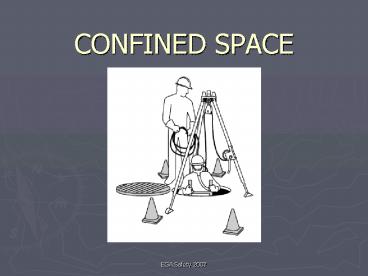CONFINED SPACE - PowerPoint PPT Presentation
1 / 30
Title:
CONFINED SPACE
Description:
How many people die or get hurt seriously in confined space accidents? ... Welding, cutting, brazing, soldering. Painting, scraping, sanding, degreasing. ... – PowerPoint PPT presentation
Number of Views:113
Avg rating:3.0/5.0
Title: CONFINED SPACE
1
CONFINED SPACE
2
(No Transcript)
3
Confined Space Entry
- Construction Industry Standard 1926.21(b)(6)
- General Industry Standard 1910.146
- Best Practices for all Industries
4
Typical Confined Spaces
- Boiler, Degreaser, Furnace
- Pipeline, Pit, Pumping Station
- Reaction or Process Vessel, Mills
- Septic Tank, Sewage Digester
- Silo, Storage Tank, Barges
- Sewer, Utility Vault, Manhole
- Trenches, Shafts, Caissons
5
Criteria of a Confined Space
- 1) Large enough to bodily enter and work
- 2) Limited entry and exit
- 3) Not designed for continuous human occupancy
6
(No Transcript)
7
Construction site confined space
8
Utility site confined space
9
Limited Access
10
Unsafe access to work space
11
(No Transcript)
12
How many people die or get hurt seriously in
confined space accidents?
Prior to applying the OSHA Confined Space
Standard 63 Fatalities 5,931 Lost workday
cases 6,951 Non-lost workday cases
13
How many people die or get hurt seriously in
confined space accidents? (Cont.)
The numbers of deaths and injuries if the OSHA
standard is followed 9 Fatalities 890 Lost
workday cases 1,043 Non-lost workday cases
14
How many people die or get hurt seriously in
confined space accidents? (Cont.)
The numbers prevented by following the OSHA
standard 54 Fatalities 5,041 Lost workday
cases 5,908 Non-lost workday cases
15
Permit Required Confined Space is
- 1) Hazardous Atmosphere
- -Exists or has the potential to exist
- 2) Engulfment Hazard
- -Water, sludge, grain, etc....
- (3) Entrapment Hazard
- -Hoppers, converging pipe, etc.......
- 4) Any other Health or Safety Hazard
- -Fall, heat, trip, varmints, etc........
16
Categorizing Work Space
Space large enough to enter Limited or
Restricted entry or exit Not designed for
continuous worker occupancy.
NO
Not a confined Space
YES
Confined Space
Permit- Required Confined Space
Non Permit Required Space
Hazardous Atmosphere
Or
Engulfment Hazard
YES
NO
Or
Configuration Hazard
Or
Any other recognized serious hazard
17
Hazards of Confined Spaces
- Oxygen Deficient Atmospheres
- Oxygen Enriched Atmospheres
- Flammable Atmospheres
- Toxic Atmospheres
- Temperature Extremes
- Engulfment Hazards
- Noise, Slick/Wet Surfaces, Falling Objects
18
Engulfment Hazard
19
Oxygen Deficient Atmospheres
- 19.5 Minimum acceptable oxygen level.
- 15 - 19 Decreased ability to work
strenuously. Impair coordination. Early
symptoms. - 12-14 Respiration increases. Poor judgment.
- 10-12 Respiration increases. Lips blue.
- 8-10 Mental failure. Fainting.
Nausea Unconsciousness. Vomiting. - 6-8 8 minutes - fatal, 6 minutes - 50
fatal 4-5 minutes - possible recovery. - 4-6 Coma in 40 seconds. Death
20
Oxygen Enriched Atmospheres
- Oxygen level above 21.
- Causes flammable and combustible materials to
burn violently when ignited. - Hair, clothing, materials, etc.
- Oil soaked clothing and materials.
- Never use pure oxygen to ventilate.
- Never store or place compressed tanks in a
confined space.
21
Flammable Atmospheres
- 2 Critical Factors
- Oxygen content in the air.
- Presence of a flammable gas, or vapor
- Presence of dust (visibility of 5 or less)
- Proper air/gas mixture can lead to explosion
- Typical Ignition Sources
- Sparking or electric tool.
- Welding / cutting operations.
- Smoking
22
Toxic Atmospheres
- Product stored in a confined space
- Gases released when cleaning.
- Materials absorbed into walls of confined space.
- Decomposition of materials in the confined space.
- Work performed in a confined space
- Welding, cutting, brazing, soldering.
- Painting, scraping, sanding, degreasing.
- Sealing, bonding, melting.
- Areas adjacent to a confined space.
23
Carbon Monoxide
- Odorless, Colorless Gas.
- Combustion By-Product.
- Quickly collapse at high concentrations.
- PPM Effect Time
- 50 Permissible Exposure Level 8 Hours
- 200 Slight headache, discomfort 3 Hours
- 600 Headache, discomfort 1 Hour
- 1000-2000 Confusion, nausea, headache 2 Hours
- 1000-2000 Tendency to stagger 1 1/2 Hours
- 1000-2000 Slight heart palpitation 30 Min.
- 2000-2500 Unconsciousness 30 Min.
24
Emergency Rescue Options
1. Employers have three options under 29CFR
1910.146(k) a. Utilize their own
employees to enter confined spaces to perform
rescue services. b. Arrange to
have an outside service perform confined space
rescues. c. Combination response.
25
Rescue Available
- What will be considered timely will vary
according to the specific hazards involved in
each entry. - For example, 1910.134, Respiratory Protection,
requires that employers provide a standby person
or persons capable of immediate action to rescue
employee(s) wearing respiratory protection while
in work areas defined as IDLH atmospheres.
26
Timely Response, Training, and Equipment
- Rescue
- Retrieval
- Ventilation Atmospheric Monitoring
- Barriers
- Access/Egress (ladders, etc...)
- Lighting
- Communication
A mechanical device shall be available to
retrieve personnel from vertical type permit
spaces more than 5 feet (1.52 m) deep
27
Standby / Rescue
- Worker assigned to remain outside the confined
space and be in constant contact with the workers
inside. - Know emergency rescue procedures.
- 2 out every 3 workers who die in confined spaces
are would-be rescuers. - Trained in use of emergency rescue equipment and
PPE.
28
On-site Rescue Teams
- Because there is a need for quick response,
on-site rescue teams are usually preferred.
29
Questions?
30
(No Transcript)































